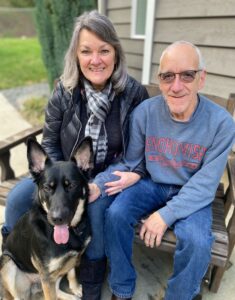Detecting and treating lung cancer in its earliest stage

Donna Pesacreta, 63, of Lacey, wasn’t expecting to be screened for lung cancer at her annual checkup with her new primary care provider.
But as part of the appointment, Monica Hallak, ARNP, at MultiCare Olympia Family & Internal Medicine inquired about Pesacreta’s smoking history.
“Monica asked me questions I’d never been asked before at a checkup,” explains Pesacreta. “She wanted to know how long I smoked, how many packs a day and how long ago I quit.”
Pesacreta quit smoking 13 years ago, but because she smoked a pack a day for more than 25 years, she was eligible for lung cancer screening due to her age and pack years.
A pack year is the number of packs of cigarettes smoked per day multiplied by the total number of years smoked. Smoking one pack per day for 25 years meant Pesacreta had a 25 pack-year history.
The U.S. Preventive Services Task Force recommends annual lung cancer screenings begin at age 50 for those with a minimum 20 pack-year smoking history.
Using advanced technology to detect early-stage lung cancer
After a low-dose CT scan revealed a suspicious spot on Pesacreta’s lungs, Hallak referred her to MultiCare interventional pulmonologist Abhishek Biswas, MD, for a biopsy.
Dr. Biswas explained he would perform a minimally invasive bronchoscopy with the assistance of the Ion robot to biopsy the spot.
“When I met with Dr. Biswas, I immediately felt comfortable talking to him — his bedside manner is amazing,” Pesacreta says. “He made me feel confident about getting the biopsy done with this technology.”
Using the Ion platform allows the surgeon to biopsy lung nodules at an earlier stage, when lung cancer is in its infancy.
“We now have the technology to go deeper into the lung than normal bronchoscopy,” says Alden Bishop, chief operating officer, MultiCare Tacoma General Hospital. “Robotic-assisted navigation helps surgeons detect cancer in the smallest nodules on the lungs.”
Bishop, who was involved in bringing the Ion to Tacoma General, says investing in these types of technologies demonstrates MultiCare’s commitment to enhancing patient care and outcomes.
“We have built a world-class, comprehensive cancer program in the South Sound,” adds Bishop. “We offer the highest level of technology combined with highly trained providers to take care of our patients. Having this ability to diagnose and treat a disease like lung cancer sooner and with greater accuracy is not only a game changer; it’s a lifesaver.”
In addition to its effectiveness, robotic-assisted bronchoscopy is also safer.
CT-guided percutaneous biopsies (the traditional procedure used to biopsy the lungs) come with the risk of complications, which occur about 15 to 20 percent of the time and are sometimes life-threatening.
“The major difference for the patient when we use the Ion is access to technology that helps us biopsy small lung nodules in a safe and effective way,” explains Dr. Biswas.
And that held true for Pesacreta: She experienced no complications and only minor side effects.
“I had the procedure on a Friday, and by Monday I was back to normal,” says Pesacreta. “Because the procedure went through my trachea, I coughed up a little blood, had a sore throat and felt tired. But these side effects were all minor and to be expected.”
The results of Pesacreta’s biopsy came back within two days.
“When Dr. Biswas got the results, he called me right away,” Pesacreta explains. “He told me I had cancer, but that it was very early — stage 1 — and he was confident it would be 100 percent removed and cured.”
MultiCare cardiothoracic surgeon Kai Engstad, MD, performed the minimally invasive surgery to remove the cancer from Pesacreta’s lung.
Pesacreta’s husband Tom says the surgery went exceptionally well, praising Dr. Engstad and the surgery team.
“Dr. Engstad and the nurses were fabulous. When we met with him, he told us exactly what he was going to do and what to expect,” says Tom. “He explained he would remove the surrounding lymph nodes in case those were also cancerous.”
After surgery, Pesacreta and her husband were relieved when they found out the lymph nodes were benign, which meant radiation and chemotherapy were not necessary.
 Lowest risk of recurrence
Lowest risk of recurrence
Lung cancer is the leading cause of cancer death for both men and women in the United States, but access to advanced technology can lead to early detection and successful treatment.
“Early detection and treatment significantly affect survival,” Dr. Biswas says. “In fact, the five-year disease-free survival rate for early lung cancer stage IA1 — the stage of Donna’s cancer — is 92 percent.”
That means she has the lowest risk of recurrence.
“From my annual checkup to my surgery, every part of my care at MultiCare felt flawless — it was like a well-oiled machine,” adds Pesacreta. “I didn’t have any negative feelings of having cancer because it was caught early and I was in such capable hands. I feel like everything is going to be OK.”
What's next
- If you’re over 50 with at least a 20 pack-year history, schedule an appointment with your provider
- Lung cancer prevention and screening at MultiCare
- Who’s eligible for a lung cancer screening, and how is it performed?



